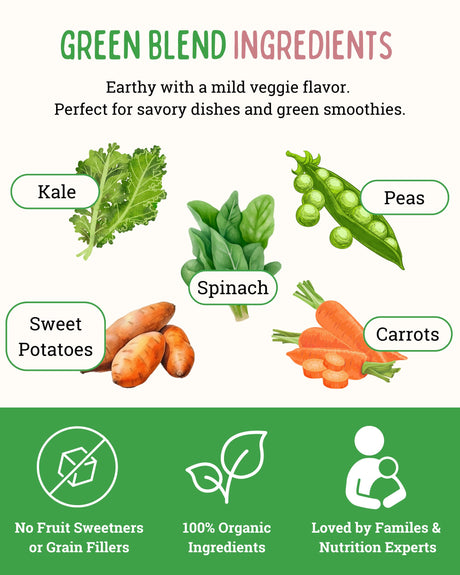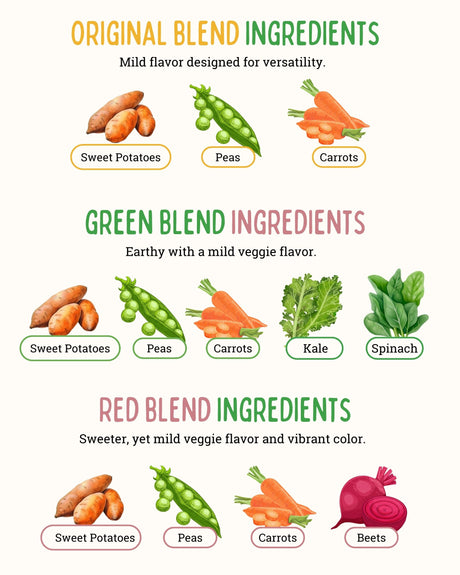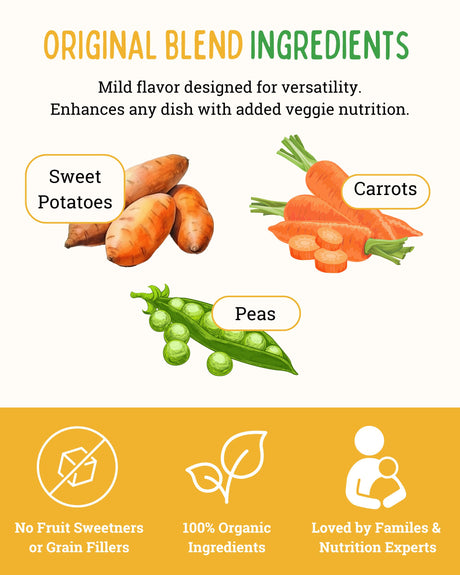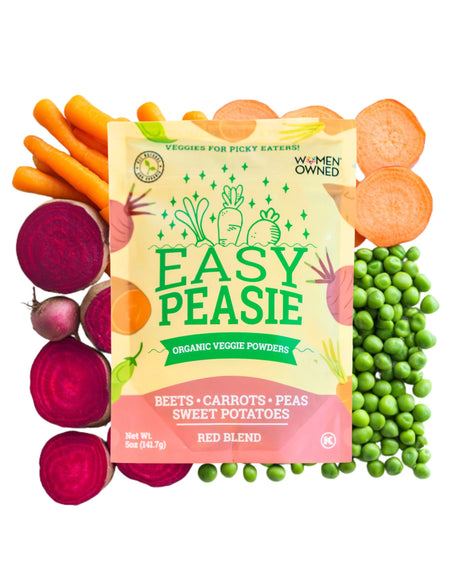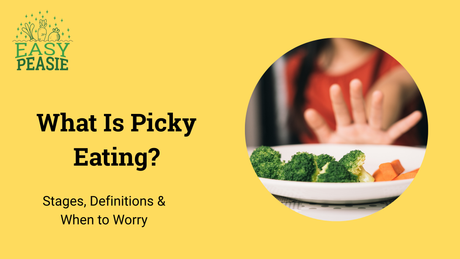You've tried every method to get your picky toddler to eat broccoli, your teenager refuses anything green, and now you're also worried about your aging parent who's lost interest in nutritious meals. The challenge of ensuring adequate vegetable intake spans generations, and sometimes the direct approach just isn't working.
While the ideal scenario involves everyone happily eating whole vegetables at every meal, real life often requires more creative strategies. Hidden vegetables - incorporating vegetable nutrition into foods in ways that are less detectable - can serve as a valuable bridge to meeting nutritional needs when direct consumption isn't happening.
Whether you're feeding resistant children, supporting aging parents with changing appetites, or even trying to increase your own vegetable intake, understanding how to strategically incorporate hidden vegetables while working toward long-term acceptance can help ensure better nutrition across all life stages.
Understanding Hidden Vegetables: Strategy, Not Deception
What "Hidden Vegetables" Really Means
Hidden vegetables doesn't mean tricking or deceiving anyone about what they're eating. Rather, it refers to incorporating vegetable nutrition into foods in forms that minimize the taste, texture, or appearance characteristics that trigger resistance.
This approach recognizes that while whole, recognizable vegetables remain the ultimate goal, getting essential nutrients into resistant eaters while working on acceptance is better than consuming no vegetables at all.
Hidden vegetables can involve:
- Pureeing vegetables into sauces or baked goods
- Finely chopping or grating vegetables into mixed dishes
- Using vegetable powders in familiar foods
- Blending vegetables into smoothies or soups
- Incorporating vegetables into foods where they naturally blend in
The Role of Hidden Vegetables in Nutrition Strategy
Hidden vegetables work best as part of a comprehensive approach that includes continued exposure to whole vegetables without pressure. They serve as nutritional insurance while maintaining opportunities for children and adults to see, touch, and eventually taste whole vegetables.
Appropriate uses for hidden vegetables:
- Bridging nutritional gaps during periods of extreme selectivity
- Supporting adequate intake when whole vegetable consumption is very limited
- Reducing family stress around vegetable intake
- Maintaining vegetable exposure in different forms
- Providing nutrition security while working on acceptance
This approach should not replace:
- Continued offering of whole vegetables at meals
- Exposure opportunities to recognizable vegetables
- Modeling of vegetable consumption by family members
- Creating positive associations with vegetables
Hidden Vegetables for Children
Why Kids Resist Vegetables
Understanding resistance helps inform effective strategies. Children often reject vegetables due to:
Developmental factors:
- Natural neophobia (fear of new foods) peaks in toddlerhood
- Preference for sweeter tastes over bitter flavors
- Sensitivity to strong flavors and unfamiliar textures
- Need for control and autonomy over food choices
Sensory sensitivities:
- Texture aversions to mushy, crunchy, or mixed consistencies
- Overwhelming response to strong vegetable smells
- Visual reactions to certain colors or appearances
- Temperature sensitivities with cooked vegetables
Age-Appropriate Hidden Vegetable Strategies
For Toddlers (1-3 years): Toddlers are establishing eating patterns and asserting independence, making them prime candidates for hidden vegetable approaches.
Effective methods:
- Pureed vegetables in pasta sauces (carrots and tomatoes blend naturally)
- Sweet potato or butternut squash mixed into macaroni and cheese
- Vegetable purees in pancakes or muffins
- Smoothies with spinach blended with sweet fruits
- Finely grated zucchini in meatballs or meatloaf
For Preschoolers (3-5 years): Preschoolers may be very particular about food appearance and presentation while developing stronger preferences.
Effective methods:
- Vegetable-based sauces blended smooth
- Cauliflower rice mixed with regular rice
- Pureed butternut squash in cheese sauce
- Veggie powder added to favorite dips or spreads
- Vegetables incorporated into familiar comfort foods
For School-Age Children (6-12 years): School-age children can often detect hidden vegetables more easily but may accept them in foods they enjoy.
Effective methods:
- Finely minced vegetables in tacos or casseroles
- Spinach in fruit smoothies (properly blended becomes undetectable)
- Veggie-packed tomato sauce over pasta or pizza
- Cauliflower or broccoli pureed into cheese soup
- Vegetable powder in baked goods or protein shakes
Making Hidden Vegetables Work for Kids
Start subtle: Begin with very small amounts of hidden vegetables and gradually increase as acceptance builds.
Choose complementary flavors: Sweet vegetables like carrots or sweet potatoes hide well in sweet foods, while mild vegetables like cauliflower work in savory dishes.
Maintain texture familiarity: If your child likes smooth foods, keep vegetables smooth. If they prefer some texture, finely chop rather than puree.
Don't announce it: Simply serve the food normally. If asked, be honest but casual: "There are vegetables in this - it helps make it tasty and nutritious."
Hidden Vegetables for Adults and Aging Parents
Why Adults May Need Hidden Vegetables
Adults and elderly family members may struggle with vegetable intake for reasons different from children but equally valid.
Common adult challenges:
- Busy schedules limiting meal preparation time
- Lifelong patterns of limited vegetable consumption
- Difficulty changing established food preferences
- Dental issues making certain textures challenging
- Decreased appetite or interest in food (especially common in elderly)
Aging-specific factors:
- Reduced sense of taste and smell affecting food appeal
- Swallowing difficulties (dysphagia) requiring texture modifications
- Medication side effects affecting appetite or taste
- Physical limitations in food preparation
- Cognitive changes affecting meal planning and cooking
Hidden Vegetable Strategies for Adults
For Busy Adults: Focus on convenience and efficiency without sacrificing nutrition.
Effective methods:
- Vegetable powder added to coffee smoothies or protein shakes
- Pre-made vegetable soups blended smooth
- Pasta sauce with pureed vegetables for quick meals
- Cauliflower rice as a quick side dish
- Vegetable-based dips for convenient snacking
For Adults with Established Preferences: Work with existing food patterns rather than against them.
Effective methods:
- Vegetables incorporated into favorite comfort foods
- Gradual modifications to familiar recipes
- Texture-modified vegetables in preferred dishes
- Vegetable powders in regular morning routines (coffee, oatmeal)
Supporting Elderly Parents with Hidden Vegetables
Aging parents often need special consideration around vegetable intake due to changing needs and abilities.
Addressing reduced appetite:
- Nutrient-dense smoothies requiring less volume to consume
- Vegetable nutrition concentrated in smaller portions
- Fortified soups that provide calories and vegetables
- Purees that are easier to consume when appetite is low
Managing texture challenges:
- Thoroughly cooked and mashed vegetables
- Smooth vegetable soups and purees
- Vegetable powders requiring no chewing
- Soft vegetable-based casseroles
Simplifying preparation:
- Ready-to-use vegetable powders requiring no prep
- Pre-made vegetable soups that can be easily reheated
- Simple smoothie recipes with vegetable powders
- One-pot meals incorporating vegetables
The Power of Vegetable Powder
What Vegetable Powder Offers
Vegetable powders represent one of the most versatile approaches to hidden vegetables, offering concentrated nutrition in a form that's easy to incorporate into various foods.
Benefits of vegetable powder:
- No texture changes to familiar foods
- Mild flavor that doesn't overpower dishes
- Long shelf life eliminating waste
- Consistency regardless of season
- Convenience requiring no preparation
Easy Peasie Veggie Powder Blends provide concentrated nutrition from vegetables like peas, carrots, sweet potatoes, kale, spinach, and beets. Two tablespoons provide nutrients equivalent to a full cup of vegetables, making it a practical solution for individuals of any age who struggle with whole vegetable consumption.
How to Use Vegetable Powder Across Ages
For children:
- Mixed into pancake or waffle batter
- Stirred into yogurt or applesauce
- Blended into fruit smoothies
- Added to macaroni and cheese
- Incorporated into meatballs or burgers
- Mixed into oatmeal or hot cereal
For adults:
- Added to morning coffee or protein shakes
- Mixed into pasta sauce or soup
- Blended into salad dressings
- Incorporated into baked goods
- Added to hummus or other dips
For elderly individuals:
- Stirred into cream-based soups
- Mixed into mashed potatoes or soft foods
- Added to nutritional supplement drinks
- Blended into fruit purees or applesauce
- Mixed into oatmeal or cream of wheat
Choosing Quality Vegetable Powder
Not all vegetable powders are created equal. Look for products that:
- Contain 100% vegetables with no fillers or additives
- Include no added salt, sugar, or artificial ingredients
- Provide clear nutritional information
- Source vegetables carefully
- Process vegetables in ways that preserve nutrients
Practical Implementation Strategies
Starting a Hidden Vegetable Approach
Step 1: Assessment Identify which foods each family member regularly accepts and eats consistently. These become your vehicles for hidden vegetables.
Step 2: Selection Choose vegetables that blend well with accepted foods. Start with mild-flavored options like cauliflower, carrots, or sweet potatoes.
Step 3: Gradual introduction Begin with very small amounts and slowly increase as acceptance continues.
Step 4: Variety Once one method works, diversify by hiding vegetables in different foods and forms.
Recipes and Applications
Versatile vegetable-enhanced foods:
Sauces and gravies: Pureed vegetables blend seamlessly into tomato sauce, cheese sauce, or gravy, adding nutrition without altering familiar flavors.
Baked goods: Muffins, breads, and pancakes can incorporate pureed vegetables or vegetable powders while maintaining familiar taste and texture.
Smoothies: Blended drinks mask vegetables effectively, especially when combined with naturally sweet fruits.
Soups: Pureed vegetable soups provide substantial nutrition in easily consumable forms appropriate for all ages.
Dips and spreads: Hummus, ranch dip, or other favorites can be enhanced with vegetable powders or finely pureed vegetables.
Maintaining Transparency and Trust
While hiding vegetables, maintain overall honesty and trust around food:
Be truthful if asked: "Yes, there are vegetables in this - they help make it nutritious."
Don't make it a big reveal: Casually including vegetables is different from hiding them as a "gotcha" moment.
Continue offering whole vegetables: Keep presenting recognizable vegetables alongside hidden ones.
Celebrate successes calmly: If someone enjoys a food with hidden vegetables, acknowledge it positively without making it a dramatic breakthrough.
Beyond Hidden Vegetables: The Long-Term Goal
Using Hidden Vegetables as a Bridge
While hidden vegetables serve important nutritional purposes, the ultimate goal remains developing acceptance of whole, recognizable vegetables.
Bridge strategies include:
- Gradually decreasing how hidden vegetables are (smooth puree → small chunks → recognizable pieces)
- Talking casually about vegetable ingredients in enjoyed foods
- Offering the same vegetables in both hidden and whole forms
- Building on successes with hidden vegetables to encourage trying whole ones
Building Acceptance Over Time
For children:
- Continue exposure to whole vegetables without pressure
- Involve in age-appropriate food preparation
- Model eating and enjoying vegetables
- Create positive associations without forcing consumption
For adults:
- Explore different preparation methods for vegetables
- Try new vegetables in various forms
- Focus on vegetables that appeal personally
- Gradually increase whole vegetable portions
For elderly individuals:
- Respect preferences while encouraging variety
- Modify textures as needed for safety and comfort
- Focus on nutrient density rather than volume
- Celebrate maintained nutrition rather than forced changes
Addressing Common Concerns
"Isn't This Just Tricking Them?"
Hidden vegetables aren't about deception but about meeting nutritional needs while working on acceptance. It's similar to how we make medicine palatable for children - the goal is delivering what's needed in a form that's acceptable.
The key difference between helpful strategy and problematic deception lies in overall approach:
- Helpful: Incorporating vegetables while continuing to offer and model whole vegetables
- Problematic: Only hiding vegetables while never exposing to whole forms or building acceptance
"Will They Ever Learn to Eat Real Vegetables?"
Research and clinical experience suggest that hidden vegetables, when used as part of a comprehensive approach, don't prevent acceptance of whole vegetables. In fact, by reducing stress around vegetables and ensuring adequate nutrition, hidden vegetables can create conditions where acceptance becomes more likely over time.
"Is This Nutritionally Adequate?"
Hidden vegetables, especially through quality vegetable powders, can provide substantial nutrition. However, they work best as part of an overall varied diet rather than as the sole source of nutrients. Regular healthcare monitoring ensures nutritional adequacy regardless of approach.
Family-Wide Implementation
Making It Work for Multiple Generations
Many families feed children, adults, and elderly parents simultaneously, requiring strategies that work across age groups.
Universal applications:
- Vegetable-enhanced pasta sauce works for all ages
- Smoothies can be customized for individual preferences and needs
- Vegetable powder additions work in many foods across ages
- Soup-based meals can be texture-modified as needed
Individual modifications:
- Adjust texture based on chewing and swallowing abilities
- Vary portion sizes appropriate to age and appetite
- Customize flavors to individual preferences
- Modify temperature based on sensitivity
Reducing Meal Preparation Stress
Hidden vegetable strategies can simplify rather than complicate meal preparation:
- One base recipe (like pasta sauce) works for entire family
- Batch preparation of vegetable-enhanced foods saves time
- Vegetable powders eliminate prep time for vegetables
- Purees can be made in advance and frozen
Hidden vegetables serve as a practical, effective strategy for ensuring adequate vegetable nutrition across all life stages. Whether supporting a picky toddler, a busy adult, or an aging parent with changing needs, these approaches bridge the gap between ideal whole vegetable consumption and nutritional reality. By combining hidden vegetables with continued exposure to whole forms and maintaining realistic expectations, families can support better nutrition while reducing stress and building long-term acceptance.
This article is for educational purposes only and does not constitute medical advice. Always consult with healthcare providers for concerns about nutrition, growth, or development for individuals of any age.



